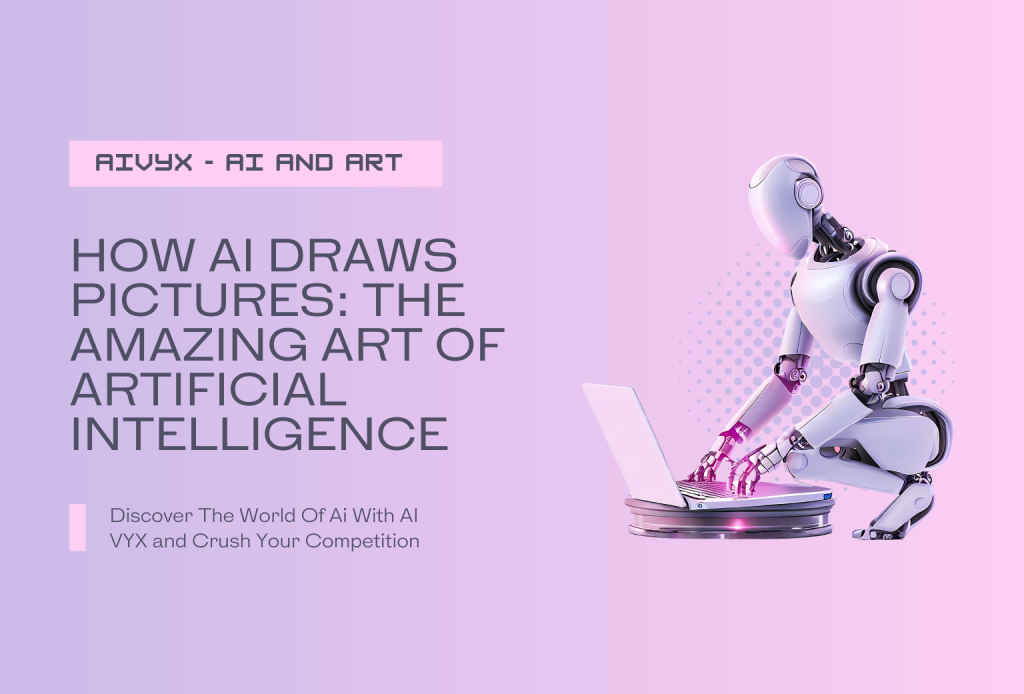Have you ever wondered how AI draws pictures?
How does it create realistic and artistic images from text, sketches, or photos?
How does it learn from human artists and generate new styles and concepts?
AI drawing is a fascinating and rapidly evolving field that combines artificial intelligence, computer vision, and creativity.
AI drawing tools can help you create stunning and unique images in seconds, using advanced machine-learning models that can understand and manipulate visual data.
In this blog post, we’ll explore how AI draws pictures, what benefits it offers to artists and non-artists alike, and what challenges and limitations it faces.
We’ll also share some examples of AI drawing tools that you can try for yourself and some best practices for using them ethically and responsibly.
How Does AI Draw Pictures?
AI drawing is the process of using artificial intelligence to generate or edit images.
AI drawing tools can use different methods and techniques to achieve this goal, depending on the input, output, and purpose of the tool.
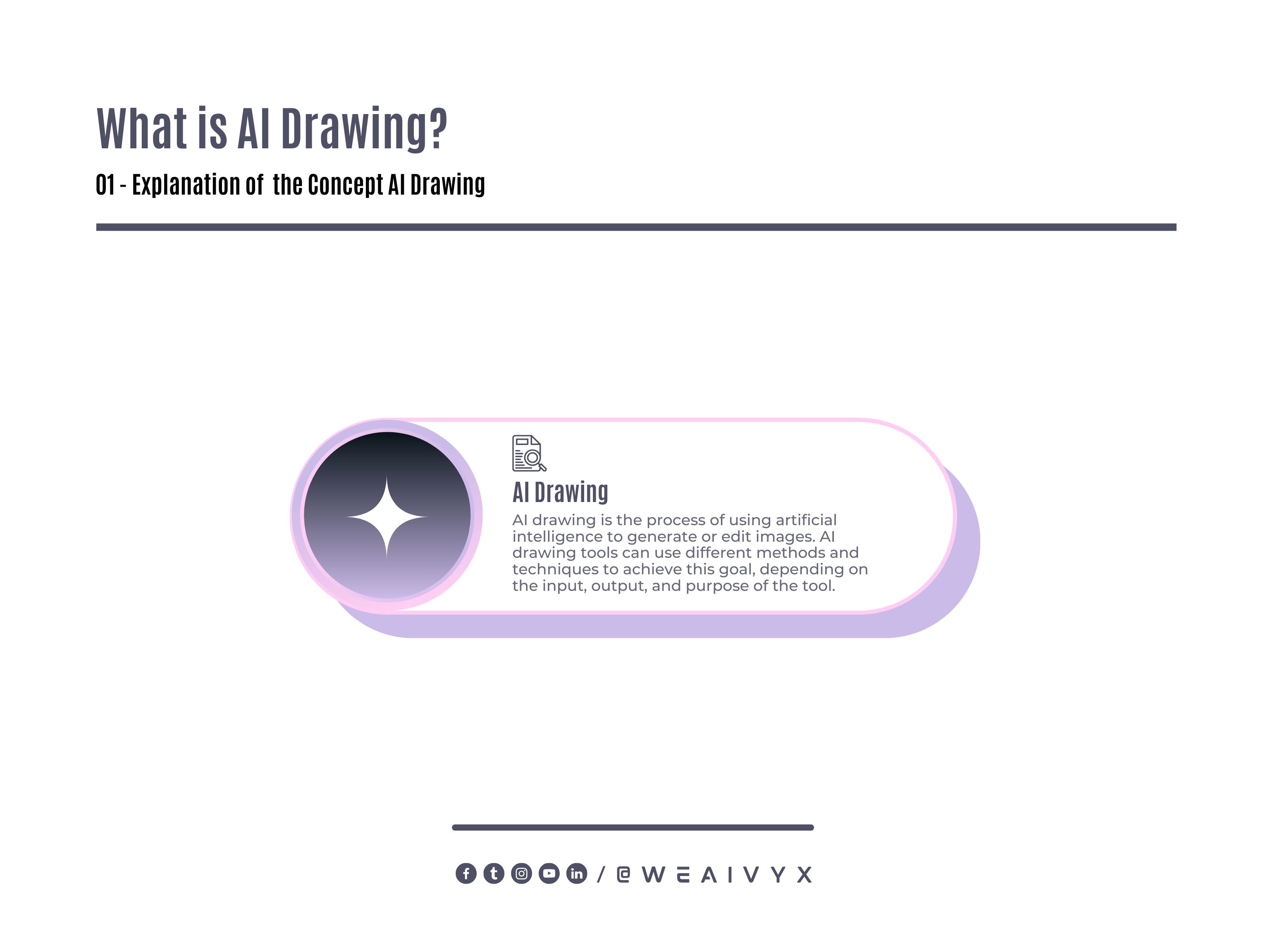
Some common methods and techniques are:
Generative Adversarial Networks (GANs)
GANs are a type of neural network that consists of two competing models: a generator and a discriminator.
The generator tries to create realistic images from random noise or text, while the discriminator tries to distinguish between real and fake images.
The generator learns from the feedback of the discriminator and improves over time.
GANs can produce high-quality and diverse images that match the input description or style.
Variational Autoencoders (VAEs)
VAEs are another type of neural network that can generate images from random noise or text.
VAEs encode the input into a latent space, which is a compressed representation of the input features.
Then, they decode the latent space into an output image. VAEs can produce smooth and coherent images that capture the essence of the input.
Image-to-Image Translation
The image-to-image translation is a technique that can transform an image from one domain to another, such as from sketch to photo, or from day to night.
Image-to-image translation tools can use GANs or other neural networks to learn the mapping between different domains and apply it to new images.
Image-to-image translation can produce realistic and artistic images that preserve the content and structure of the input image.
Neural Style Transfer
Neural style transfer is a technique that can apply the style of one image to another, such as from painting to photo, or from cartoon to portrait.
Neural style transfer tools can use convolutional neural networks (CNNs) or other neural networks to extract the style features and content features of different images and combine them into a new image.
Neural style transfer can produce stylized and expressive images that harmoniously blend the input images.
These are just some of the methods and techniques that AI drawing tools can use to create or edit images.
There are many more variations and combinations of these methods and techniques, as well as new ones being developed every day.
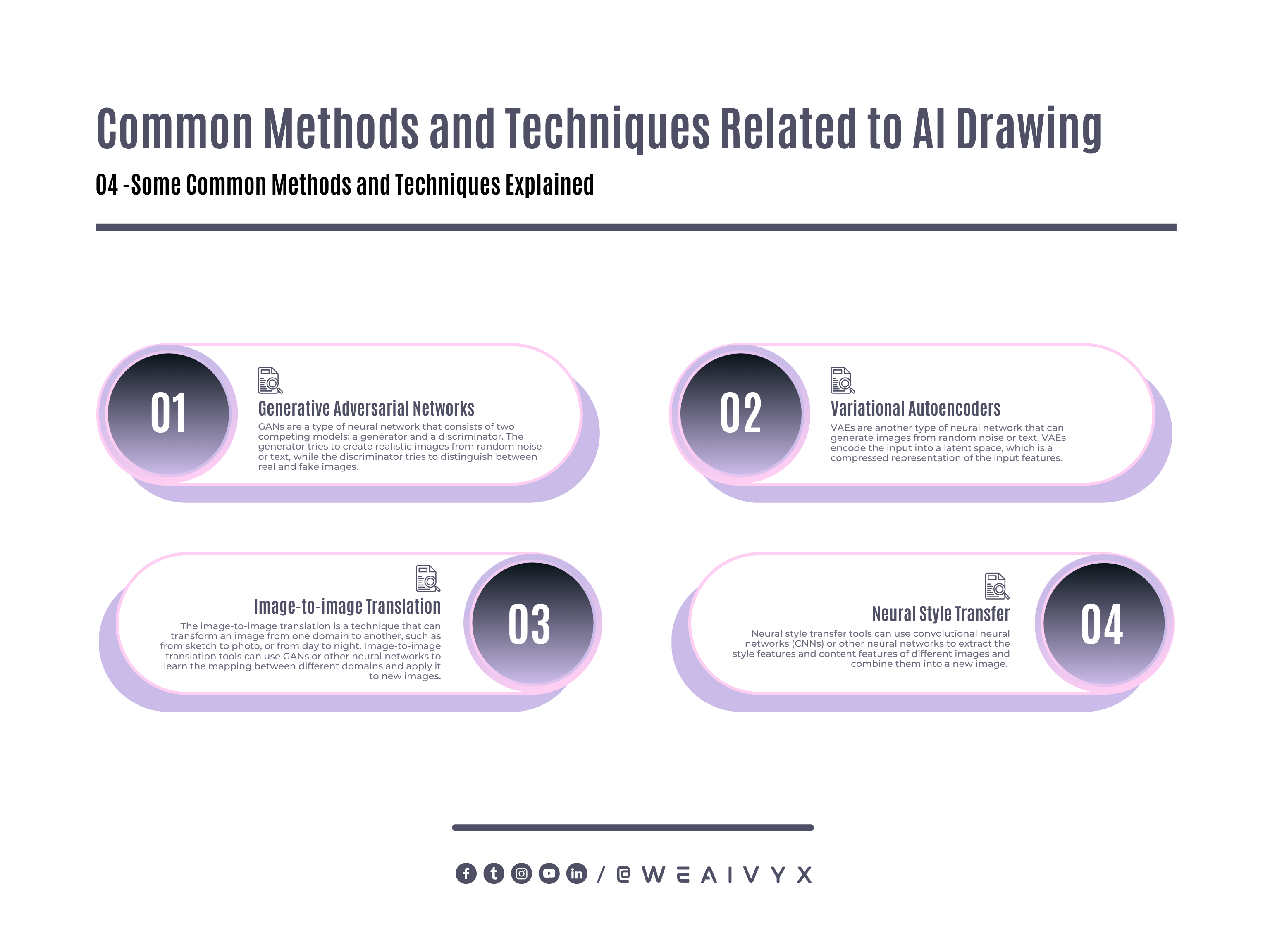
What Are the Benefits of AI Drawing?
AI drawing offers many benefits to artists and non-artists alike who want to create or enhance their images.
Some of these benefits are:
It Saves Time and Effort
AI drawing tools can generate or edit images in seconds, without requiring any manual intervention or artistic skills.
You can simply enter a text prompt, upload a sketch or a photo, or choose a style, and let the AI do the rest.
It Boosts Creativity and Inspiration
AI drawing tools can generate novel and diverse images that you may not have thought of before.
You can explore different ideas, styles, and concepts with ease and discover new possibilities for your art.
It Enhances Quality and Expression
AI drawing tools can produce high-quality and realistic images that match your vision and expectations.
You can also adjust various parameters, such as color, brightness, contrast, etc., to fine-tune your image according to your preference.
It Expands Accessibility and Inclusivity
AI drawing tools can make art creation more accessible and inclusive for everyone, regardless of their background, experience, or ability.
You can create amazing images without any prior knowledge or training in art or technology.
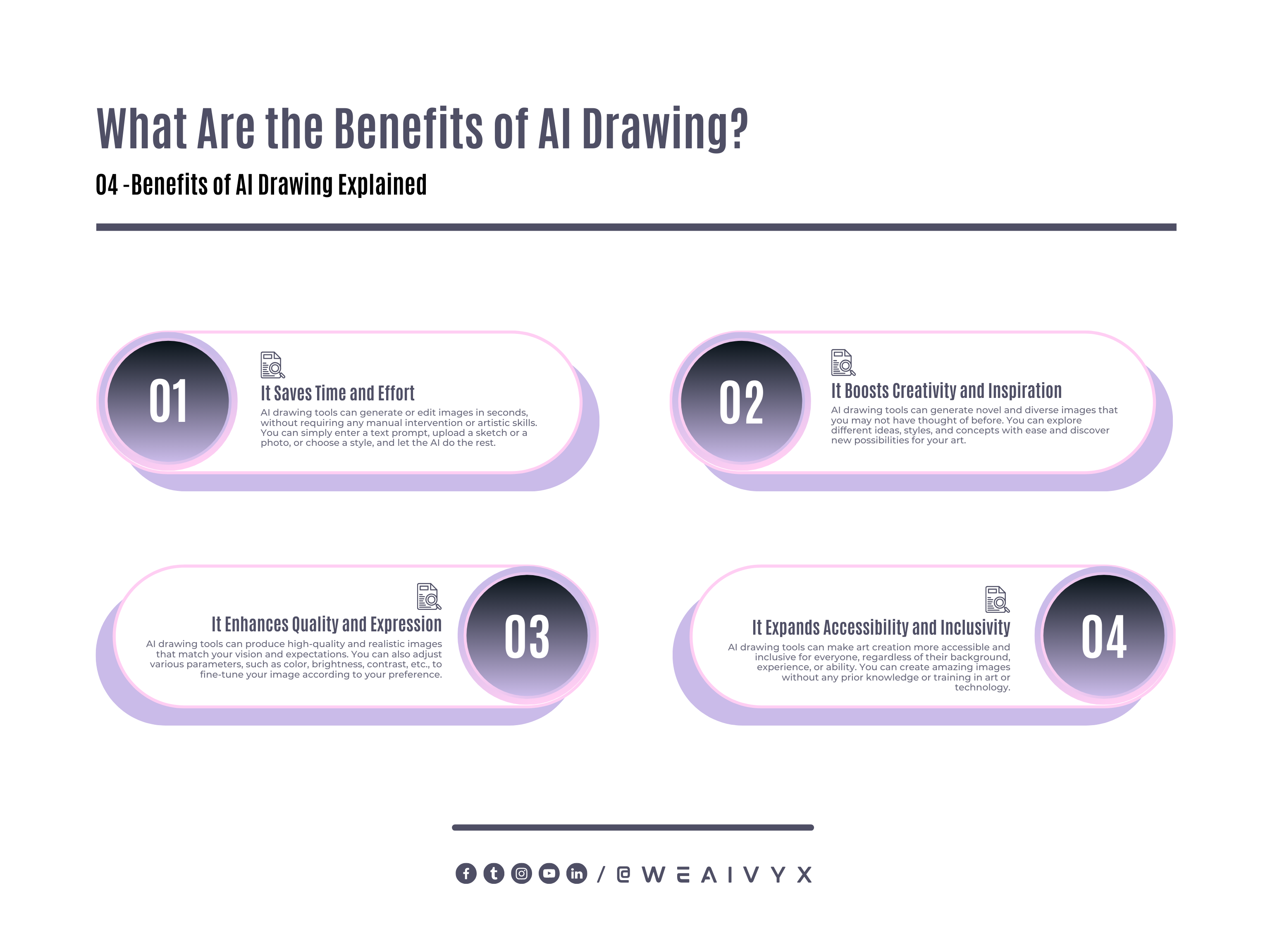
What Are the Challenges and Limitations of AI Drawing?
Not Yet 100% Accurate or Reliable
It may not always generate or edit images that match your input or intention.
It may produce unrealistic, inappropriate, or offensive images that do not reflect your desired outcome.
Therefore, you should always review and verify the output of AI drawing tools before using or sharing them.
Not a Human-Like or Natural Process
AI drawing tools do not have the same intuition, emotion, or intention as human artists.
They do not have the same cultural, historical, or social context or understanding as human audiences.
They do not have the same aesthetic, ethical, or moral values or judgments as human creators or critics.
Therefore, AI drawing tools may not always capture or convey the meaning, purpose, or significance of the images they create or edit.
Not a Collaborative or Interactive Process
AI drawing tools do not have the same communication, feedback, or learning mechanisms as human artists.
They do not have the same ability to adapt, improvise, or innovate as human collaborators.
They do not have the same responsiveness, engagement, or appreciation as human viewers.
Therefore, AI drawing tools may not always meet or exceed the expectations, needs, or preferences of the users or stakeholders involved in the image creation or editing process.
Not a Transparent or Explainable Process
AI drawing tools do not have the same logic, reasoning, or evidence as human artists.
They do not have the same documentation, annotation, or citation as human sources.
They do not have the same accountability, responsibility, or liability as human agents.
Therefore, AI drawing tools may not always provide or justify the rationale, process, or outcome of the image creation or editing process.

These are some of the challenges and limitations of AI drawing that you should be aware of before using or sharing AI drawing tools.
You should also be aware of the ethical and social implications of AI drawing and follow some best practices for using them ethically and responsibly.
How to Use AI Drawing Tools Ethically and Responsibly?
AI drawing tools are powerful and fun, but they also come with ethical and social implications that you should consider before using or sharing them.
AI drawing tools can raise issues such as:
Intellectual Property and Ownership
Who owns the rights to the images generated or edited by AI drawing tools?
How can you protect your rights or respect the rights of others?
How can you avoid infringing or violating any laws or regulations regarding intellectual property and ownership?
Privacy and Security
How can you avoid infringing or violating any laws or regulations regarding intellectual property and ownership?
How can you prevent unauthorized access, misuse, or abuse of your data or the data of others?
How can you comply with any laws or regulations regarding privacy and security?
Bias and Fairness
How can you avoid or mitigate any bias or unfairness that may be present in the AI drawing tools or their output?
How can you ensure that the AI drawing tools or their output do not discriminate, harm, or offend anyone based on their identity, background, or characteristics?
How can you promote diversity, inclusion, and equity in the AI drawing tools or their output?
Accountability and Transparency
How can you ensure the accountability and transparency of the AI drawing tools or their output?
How can you understand how the AI drawing tools work and what factors influence their output?
How can you provide feedback, report errors, or request explanations for the AI drawing tools or their output?
To use AI drawing tools ethically and responsibly, you should follow some best practices, such as:
Respect Intellectual Property and Ownership
Respect the intellectual property and ownership rights of yourself and others.
You should always cite and reference any sources or tools that you use in your work.
You should also seek permission and give credit to any authors or creators whose work you use or modify.
You should not claim or imply that the work of others is your own or that you have any rights over it.
You should also respect any terms of use, licenses, or agreements that apply to the sources or tools that you use.
Protect the Privacy and Security
Protect the privacy and security of yourself and others.
You should only use or share data that you have permission to use or share.
You should also use secure platforms, devices, and networks when using or sharing data.
You should not disclose any personal or sensitive information about yourself or others without consent.
You should also delete any data that you no longer need or use.
Avoid Any Bias or Unfairness
Avoid or mitigate any bias or unfairness in yourself and others.
You should be aware of your own biases and assumptions when using or sharing AI drawing tools.
You should also check the quality and accuracy of the AI drawing tools and their output and look for any signs of bias or unfairness.
You should also seek diverse perspectives and opinions from others who may have different views or experiences than you.
You should also challenge any bias or unfairness that you encounter in yourself, others, or the AI drawing tools.
Ensure Accountability and Transparency
Ensure the accountability and transparency of yourself and others.
You should be honest and clear about your use and purpose of AI drawing tools.
You should also explain how the AI drawing tools work and what factors influence their output.
You should also provide feedback, report errors, or request explanations for the AI drawing tools or their output.
You should also acknowledge any limitations, uncertainties, or risks associated with the AI drawing tools or their output.
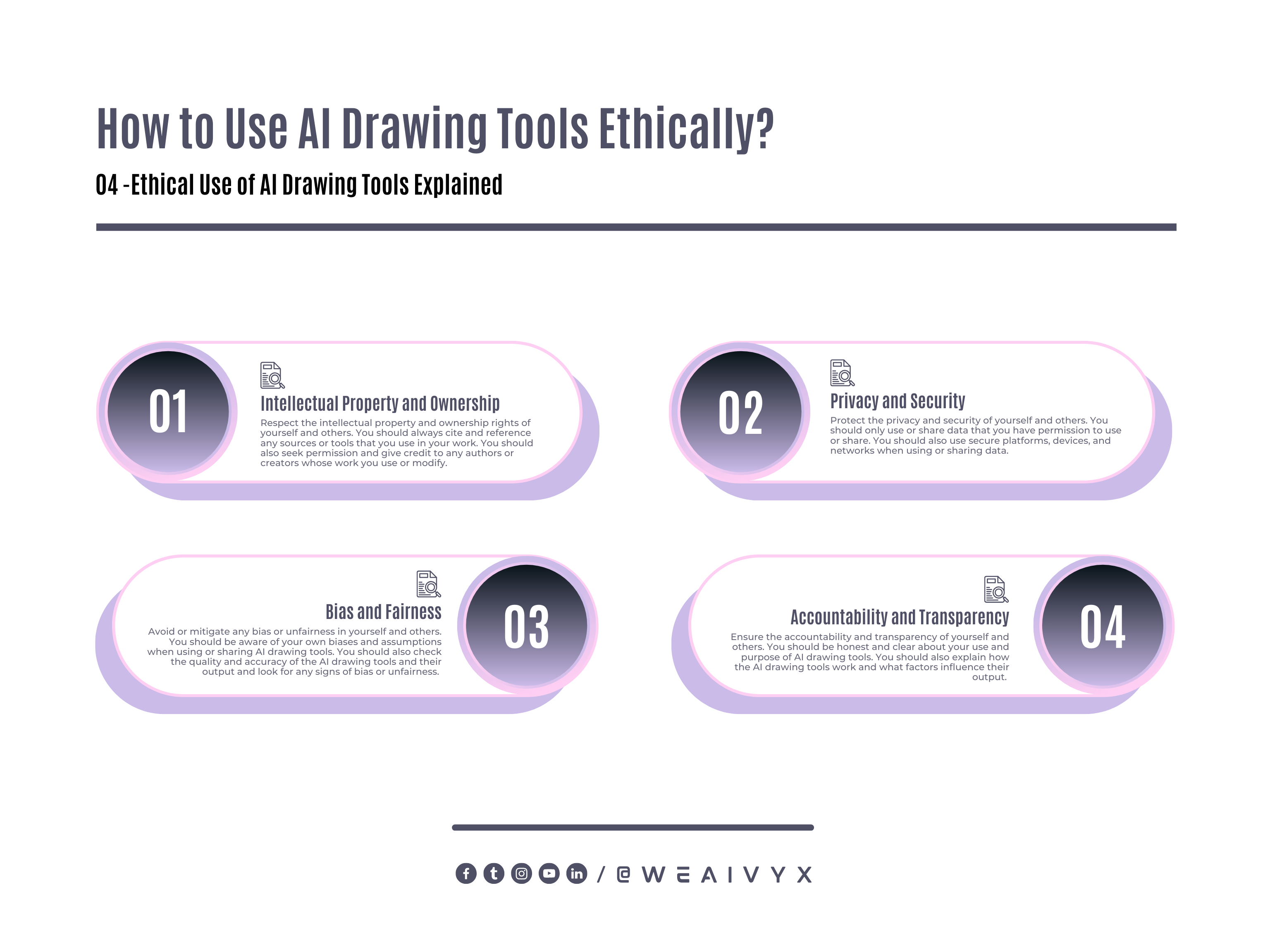
By following these best practices, you can use AI drawing tools ethically and responsibly in your work.
You can also contribute to the development and improvement of AI drawing tools and their impact on society.
Conclusion
AI drawing is a fascinating and rapidly evolving field that combines artificial intelligence, computer vision, and creativity.
AI drawing tools can help you create stunning and unique images in seconds, using advanced machine-learning models that can understand and manipulate visual data.
AI drawing offers many benefits to artists and non-artists alike who want to create or enhance their images.
However, it also has some challenges and limitations that require further scrutiny and human judgment.
To use AI drawing tools ethically and responsibly in your work, you should understand how they work, what they can do, and what they cannot do.
You should also respect the rights, privacy, security, diversity, inclusion, equity, accountability, and transparency of yourself and others.
We hope this blog post has given you some useful information about how AI draws pictures.
